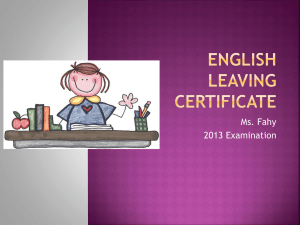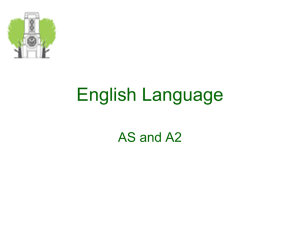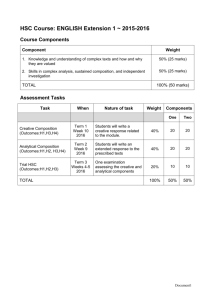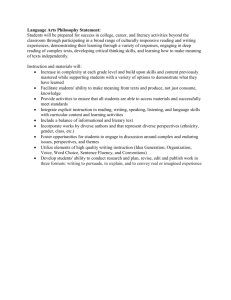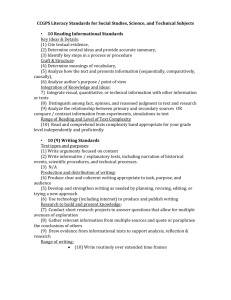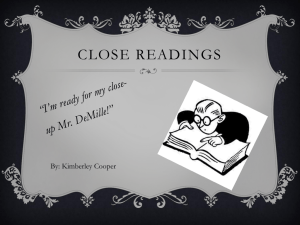A2 Revision Booklet June 2011 MEST 3 Exam Thursday 16th June
advertisement
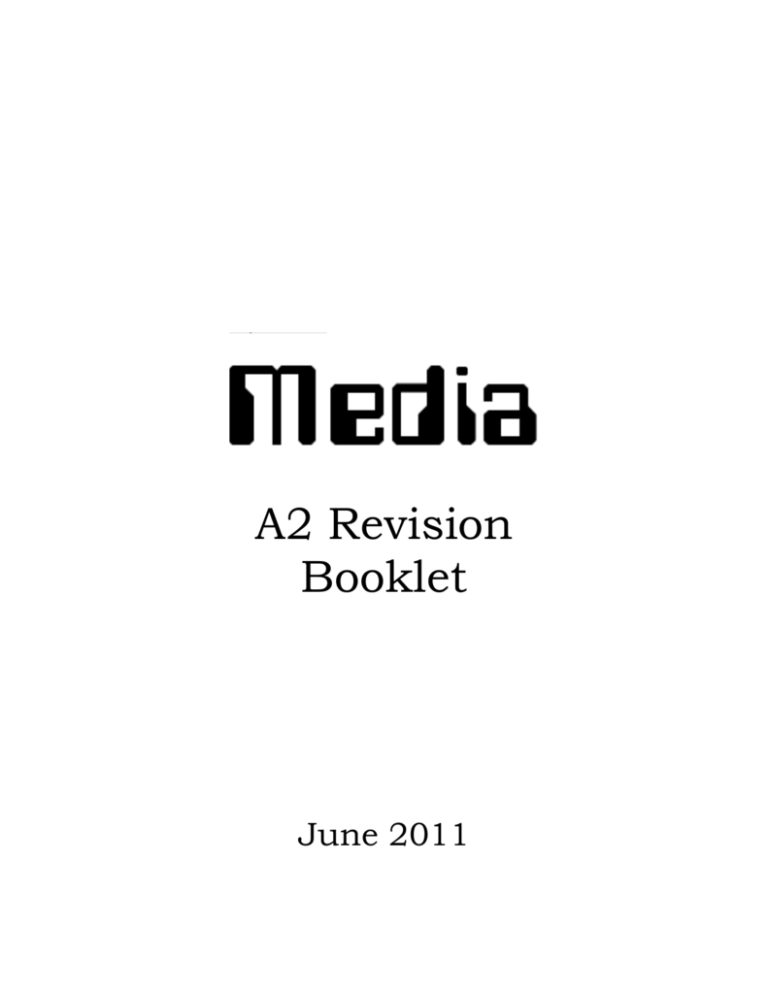
A2 Revision Booklet June 2011 MEST 3 Exam Thursday 16th June PM 2Hrs Section A 1 hour including 15 minutes reading/viewing time 32 Marks The first section will be based around unseen stimulus materials which may be print, e-media, audio or moving image based. The stimulus materials will be designed to be easily assimilated by candidates in the space of 15 minutes and there will be time for note-taking and essay planning. The materials will be chosen to raise issues about: • media concepts (form, representation, institutions, audience, values and ideology) • wider contexts • media issues and debates. There will be three compulsory questions based around the stimulus materials. The questions will demand short answers to demonstrate knowledge and understanding of the media. Section B (60%) 1 hour 48 marks Candidates will have been given two pre-set topic areas for study during the year. They will be expected to answer one question from a choice of questions linked to the pre-set topics. Questions will be open-ended so that candidates can respond to the question utilising the media texts that they have studied throughout this course through the application of their synoptic knowledge and understanding of the media. Representation Impact of New Media Assessment Objectives AO1 Demonstrate knowledge and understanding of media concepts, contexts and critical debates AO2 Apply knowledge and understanding when analysing media products and processes (and evaluating own practical work) to show how meanings and responses are created Key Concepts Audience Genre Narrative Media language/form: Codes and Conventions Representations Institution Media Debates Representation Effects on Audience Reality TV News Values Moral Panics Post 9/11 and the Media Ownership and control Regulation and censorship Media Technology and the digital revolution Media Theories Semiotics Structuralism and Post-Structuralism Postmodernism Feminism Ethnicity Genre theory Audience theory Marxism, Hegemony and Liberal Pluralism Cultural Imperialism Cross-Cultural factors Globalisation SECTION A You must be confident in your ability to deconstruct texts quickly picking up on the key aspects of form, codes and conventions and be able to use the right terms, vocabulary to describe the texts and their effects You must be confident in your ability to compare and contrast two texts, possibly from two different platforms in terms of form or subject matter You must be confident in your ability to apply relevant theory to the text You must be confident in your ability to consider wider contextual, cultural and ideological issues concerning the texts. Question not just HOW the text producers have constructed meaning but WHY they have constructed the meanings they have and with what possible effects on the audience. Deconstructing Texts Technical Elements of Moving Image Mise-en-Scene /Framing : everything that is included in the frame Composition : How the elements of the scene or frame are organised Camera Angles: Low, Eye level, High, Bird’s eye, Tilted Camera Shots: Establishing or Extreme Long shot, Long shot, Medium shot, Point of View shot, Over The Shoulder shot, Close-up, Extreme Close-up, Bridging shot, shot/reverse shot Camera Movement: Panning, Tilts, Tracking, Zoom, Aerial, Handheld Editing: Quick cutting, Cutaways, Wipe, Fades, Montage B-roll footage Anchorage Sound: Diegetic and Non-diegetic Lighting: high key, low key, filtered, saturated and de-saturated Colour Weather Set Location Contrast (music – asynchronous sound, image, voiceover etc.) Set-ups Idents Technical Elements of Print Masthead Headlines Sub-headings Banners Boxes Bullet points Captions Visual Image Text to image ratio Colour Contrast Anchorage Emotive Language Imperatives Rhetorical Questions Personal Pronouns Facts and Statistics Typography: Font, size, colour etc. Coverlines Inverted pyramid structure Key Concepts Barthes Signs and Semiotics Objects can be read as signs and these can be interpreted literally (denotation – a dove is a type of bird) or symbolically (connotation – a dove is a symbol or sign of peace). Media texts are made up of a series of signs that combine to make meaning. Hall’s theory of Readings Specific signs can be put into media texts to create a specific meaning. These texts are encoded with messages and the audience decode the message when they engage with the text. Advertising does this alot when the audience encode the message that a particular product will make you happier, more successful, more popular etc. The decoding of a text is also called a reading and these can be preferred, negotiated or oppositional. A person smoking could be decoded as, and connote to some - sophistication or cool, to others ill-health or stupidity and to others anti-social behavior or a desire to be non-conformist. Other signs (dress, body language, facial expressions etc.) will add together to suggest one of these interpretations stronger than another. All messages could be seen as polysemic – and at best media text producers will achieve negotiated readings. Audiences will accept most of the dominant or preferred reading but reject some aspects of it. Nobody can predict or dictate how a person will read a message. Audience Audiences traditionally classified through demographics - age, gender, location, status etc. This led to A, B, C1, C2, D categories. More recent audience classification through psychographics – values, political beliefs etc. Types of audience include Primary, Secondary, Niche and Mass. Many media theorists believe there is no mass audience in the digital age as because of market or audience segmentation. Narrowcasting is taking over Broadcasting and the number of texts which can attract large numbers of television viewers is decreasing rapidly. The same is true of film, where the industry relies on formulaic blockbusters or franchises to generate large incomes. In addition, many argue the world of print media is dying but The Sun and The Mail still have significant readership in the UK. A good example demonstrating change is the Independent publishing I paper. This is a print media product, for a niche audience to supplement and boost the sales of the conventional ‘parent’ product. Although choice has grown significantly, mass appeal texts still exist and have remained largely unaffected (Eastenders, Coronation Street, Harry Potter Franchise etc.) Cultivation/Desensitization theory: audiences adopt the views and beliefs presented by the media over time and become desensitized to aspects such as violence, political bias etc. Two-Step Theory: that our media consumption is shaped by the opinion leaders who influence our critical reception of media texts. These opinion leaders can be reviewers, award givers, news programmes which highlight or make texts prominent or even our peers who shape opinion through social media. Uses and Gratifications theory: that media is used by audiences for entertainment/diversion, information/surveillance, maintaining personal relationships, personal identity. This theory suggests that all media consumption is positive for the audience. The Audience is King making conscious choices about what to watch and consume. But a criticism of this is that these needs are created by the media and that they create needs that only they can fulfill, making the audience once again vulnerable to the ‘effects’ of the media. If the audience are ‘King’ they are still constrained by several factors such as expense – not all channels are free and not all people can have access to all consoles, games, films, internet experiences. Access could be restricted for a variety of reasons by a variety of institutions Unintended access the internet in particular delivers us to countless advertisers which we have no control over. Audiences are products. Audience can also be described as subversive and will continually seek to oppose the dominant ideology being delivered. This is a powerful argument – consider how audiences responded to the digitalization of music, the response to viral campaign of Cloverfield, the audience response to Justin Bieber, X Factor etc. The top-down force (the media industries) try to push values on the audience which significant groups reject, criticize and mock. These have been termed as the resistant audience. Questions to consider: 1) To what extent does the media construct viewpoints that the audience automatically accepts? 2) Many media audience theories ignore the role of pleasure in considering consumption of media texts. How far do you agree? 3) Audience segmentation is essential to deliver audiences to advertisers. How far do you agree? Narrative All media texts have narrative. Narratives are the threads which pieced together make meaning. A narrative is constructed from elements of form (codes and conventions) and representation. Barthes’ states that narrative codes typify the style of ‘unfolding’ of the story (action codes, enigma code etc.) Sometimes students find this difficult to identify when they are deconstructing print media. In Print, look for meanings which have been constructed through the relationships between character types (heroes, villains, victims). Also look carefully at language to used create these characters (emotive, strong adjectives) and the images used. Genre In media Genre is important for rapid identification of the text by the audience. This is essential in texts where time is money such as advertising. Consumers need to be able to recognize in seconds the type of advert with regard to narrative structure, product and outcome. In other types of programming too, audiences use their prior knowledge and understanding to create meaning from the images they read on the screen. These sets of signs from which text producers can make choices (crime fiction: male detective/female detective, smoking/alcohol, femme fatale/innocent woman, well dressed in suit/scruffy shows difficult personal life, urban environment) are called paradigms. Chained together these create a syntagm (a new meaning from the added signs). The paradigm and the syntagm are central to creating genre. Like Representations, genre changes and adapts over time and moulds itself to our ever changing culture and society. A typical Postmodern feature is that of the hybrid genre, which uses several paradigms, fuses them together to create an original genre e.g docu-soap, sci-fi comedy, rom-com etc. this fusing together of genre also bridges divides and can double or maximize audience figures. Parody and Pastiche are also features of postmodern media. Both are thought to be generally good-natured mimicry of a style or form rather than aggressive mockery and criticism, although pastiche is gentler than parody. Parody often takes a genre or specific film and subverts it exaggerating some of the codes and conventions (Scary Movie/the Office). Pastiche on the other hand tends to weave elements of a genre into another. A further postmodern feature is intertextuality which uses existing narrative within another to create a new text. Questions to consider: 1) Is the concept of genre still a useful tool given the increasing use of hybrid forms? 2) How has parody been used in contemporary media? Institution Historically, media has always been produced by the rich and powerful. Only a select few have the funds and resources available to own and create an institution for broadcasting or publication. These are major operations requiring large sums of money. The digital revolution has changed this but to what extent? Anyone with a computer, internet connection and digital video camera can broadcast to an audience – creating websites, blogs, video content, even their own ‘tv channel’ or ‘radio station’. The large corporations – conglomerate and independent, are still the most viewed, most bought and most trusted sources for information and entertainment. There has been a shift however. UGC is an increasingly common feature of the media but is supplementing it rather than replacing it. Audiences have more interaction and control over their media choices but it could be argued that it is still the institutions that are providing those choices – manipulated and mediated by them. A negative shift is the power of the conglomerate and their ownership of vast numbers of smaller companies resulting in a watering down of diversity and promotion of a single dominant view. Commercial channels need to be fiercely competitive in the media saturated market. A company like ITV must be as competitive as possible to attract audiences so that sponsors and advertisers will continue to pay high rates for advertising. With low viewing figures, advertisers will go elsewhere to ‘get’ the audience. One outcome of this is the need to drive the cost of programmes down as far as possible, using members of the public to be the stars of the show, buying in programmes from abroad, or using the same programme set and actors/stars to make a variety of programmes (Big Brother, BBLB, 24hr coverage, What happened next type programmes and more recently Eastenders and E20). This maximizes the investment or initial outlay. Other ways the institution can make money include exporting programmes abroad and premium rate phone lines. Media Debates Representation Media representations either reflect or, over time, create dominant ideology. Signs together also create powerful meanings. A syntagm is a sequence of signs which add together to create new meaning. An example of this is a montage – picture 1 + picture 2 = meaning. A paradigm is a related set of signs which are alternatives of each other. An example of this is a journalists use of the word ‘evil’ rather than ‘bad’. Representation in media becomes an issue for debate particularly in the representation of gender roles, race and ethnicity, age, ability, social status. Questions to consider: 1) Media representations of the world appear so natural that we can easily see them as real. To what extent do you think this is true? 2) How far is it possible for the media to produce fair and accurate representations? Reality TV In a multi-channel world and mentioned already, competition is fierce and the need to broadcast programmes which are cheap and attractive to the highest number of viewers is vital. Hence the enduring appeal of reality TV for the broadcasting institutions. How does this explain the lasting audience appeal? Reality TV has grown and developed into many different forms which can attract the broadest range of viewers. Uses and theory would suggest that reality TV now fulfills the all needs: maintaining personal relationships, affirming personal identity, diversion/entertainment and surveillance/ information as many can share knowledge on a range of skills, professions or topics. Often at the heart of these programmes is the element of emotional realism which hooks the audience into investing their time and loyalty. With voyeuristic power, audiences are given access to some of the most difficult moments that public and celebrity participants have to go through. Part of these hooks are created by ‘coming up’ and ‘next time..’ sequences, again rewarding the audience for staying till the very end. The never-ending and highly familiar narrative cycle including tension, conflict and resolution keeps audiences satisfied. News and Documentary News is seen as central to any study of media and culturally, politically and historically vital to our understanding of the world. News presents us with information locally, nationally and globally that we would otherwise not have access to. News plays an important ideological role in interpreting the world for us that shapes our attitudes and beliefs. This is partly the reason for Baudrillard’s concern about our media created ‘reality’ within which we exist. The Digital age has changed news dramatically: Digital services have enabled 24hr rolling news channels. This has stimulated greater need for round the clock information and constant updates. Terrestrial news has responded to these new demands by using ticker tape style bulletin updates, 60 second news programmes on TV and tabloid sized quality papers and successful commuter papers like Metro and now i. Internet sites concentrate on headlines and condensed stories Internet and phone apps allow audiences to select the news they are interested in which means they can ignore other news. An interesting point to note is that whereas news from the BBC prides itself on unbiased objectivity and fulfilling its mission statement ‘to inform’, and channel such as Sky prides itself on being ‘first for news’. Speed of information as well as 24 hour supply is becoming increasingly important. Other points of importance regarding news: News more often than not focuses on the negative News has been accused of dumbing down – trivializing important issues focusing more on sensational stories News is also a commodity like any other and many institutions are governed by the need for profit and good viewing/circulation figures – with regard to the points above conflict and celebrity sell. Each story featured is a possible story from a range of other stories which could have been chosen – a paradigm. The way these stories are placed in hierarchical order next to each other in a news bulletin or in a paper is a syntagm Questions to consider: 1) How have recent changes had an impact on news coverage? Give examples to support your answer. 2) Bias in news in inevitable. Do you agree? 3) Who selects news and why? Moral Panics Media has a long history of moral panic and witch hunting. Some more recent examples include influence of violent games on behavior and overuse of game consoles, influence of ‘hardcore’ music such as Slipknot, Marilyn Manson etc., spread of viral diseases like Swine Flu, Sars, Bird Flu etc., Social media’s links to Paedophiles, Teenagers including gangs and knife-crime, Islam and the threat of terrorism, Asylum seekers, Benefit ‘scroungers’ and out of control and offensive Comedians. Many of these panics are symptoms of the moment in time we are caught up in. It is rare these days to read endless stories of young people’s involvement in drug culture and the threat this causes to society. Moral panics reach a crescendo and then rapidly disappear. It is interesting to consider where the blame or judgement lies in a moral panic. It is usually the Government, the Family, the Masses or society as a whole, the Other (China, Middle Eastern nations, etc.) . Is it ever the media themselves? Moral panics work by feeding into existing fear or concern, showing the public the outcome of that fear (death, illnesss, decline etc.) and passing a judgement. Questions to consider: 1) How do the Media present themselves and their role in the moral framework of society? 2) How does the media benefit from this role? Post 9/11 and the Media As we have seen already narrative clearly changed Post 9/11 particularly the narrative of Action film and the role of the Action hero. Some theorists have noted that in the years following the US also became keen on the ‘Good vs Evil’ narrative and the ‘just war’ narrative with a return to films and games on WW2 to show how justifiable war is when faced with an evil enemy. Post 9/11 there was also a shift in the representation of the Other. This moved unsurprisingly, to Middle Eastern countries. This fear deepened when attacks happened subsequently by US/UK nationals who were Muslim Fundamentalists. Has this caused a fear of all ‘Other’ ? Could this also explain the obsession with unknown ‘Other’ of sci-fi – aliens, zombies, vampires. Vampire and Zombies are particularly interesting as the ‘one of us’ but ‘not us’ fear can be explored fully. Ownership and control, Regulation and censorship Significant changes in recent years to traditional media include Shrinking ‘traditional’ industries – print media, music industry especially the CD market, DVD sales Expanding digital industries which in some cases are out of the institutions control – music file sharing, film downloads, online print media content. The changes from mass audiences to a segmented market leading to a huge variety of products and choice. However, take a closer look at the choices. Are many produced by a single corporation seeking to maximize their profits? The rise of the conglomerates leading to a small group of about 8 corporations responsible for the creation, production and distribution of nearly all major media products in the world. Some argue this contributes to the dominant Western world view. It also narrows the range of choice of products and can restrict the freedom of the text producers. The rise of UGC and mass-amateurisation making some previously highly skilled professionals in the industry – redundant. Social media, blogging, comments etc, are all examples of everyday audience interaction with and shaping of media content. This is not ‘controlled’ in a traditional way. Content can be filtered by official sites but the vastness of the web means no organization can ever have the power to mediate all daily traffic. Oppressive regimes around the world have experienced serious uprisings in recent years. The power of social media and image sharing particularly from one culture to another cannot be ignored. On demand services mean that there is no ‘watershed’ and content is freely available to audiences. Even though content is flagged as being only suitable for over 18’s, unless parental controls are set on the computer, they are accessible to all. There have been several high profile cases regarding privacy and the Web. The recent Footballer Twitter super-injunction is a good case in point. Debate still rages on about the ‘public right to know’ what media figures are up to and whether ‘it is in the public interest’ for private lives to be exposed. These issues became public concern in recent years as facebook was called into question over their privacy policy and comments left on wall’s were considered in the public domain rather than private chat. Media Theories Semiotics Semiotics is how audiences create meanings from messages from the systems of codes and signs. Structuralism and Post-Structuralism Structuralism is the process of deconstructing texts by examining the underlying generic structure. The theory is that the meaning exists within texts but is deep rooted because its construction is natural to us, we have created the text naturally without conscious thought – we just need to deconstruct the text to find it and understand it. Post-structuralists would argue that this deep rooted structure should not be analysed as there is no concrete meaning - signs are open to an infinite number of interpretations and so do not have any useful meaning or pattern. Postmodernism Postmodernism is not a theory but more a collection of elements that add together to make a text postmodern. These elements include intertextuality, bricolage, pastiche, parody, hybrid, CGI, Simulcrum and Hyperreality. Feminism Feminism seeks to challenge traditional power structures that exist between the genders. Some would argue that as Media institutions are predominantly run by ‘white, middle/upper-class men’ their ideology is prevalent in media texts which then perpetuates the dominant ideology in society. This has major implications for those in society who are women, non-white and working class. Mulvey suggested that all media is created through the eyes of the heterosexual male, called the ‘male gaze’ and that as a result women are viewed in terms of the pleasure they give to men. Post-feminism allows women to use their sexuality for their own benefit giving them power. Signs which are associated with femininity (heels, lipstick etc.) are used against men as weapons to make them vulnerable rather than the other way round. Marxism, Hegemony and Liberal Pluralism Marxism is the idea that the elite few are in a continual state of conflict with the many or the mass. The powerful elite wants to pay as little as possible for the labour of the mass. The mass wants to get as much out of their work as possible. It is therefore the role of institutions like the Media to keep the mass happy so that they continue to offer their full support to the capitalist ideals. Marxists would argue that the media’s use of celebrity is such a device – used to create a diversion, keeping the minds of the masses off of the more serious issues like working conditions, pay and rights. Hegemony takes this idea a step further suggesting that the dominant group persuades the mass that the power structure is necessary and more importantly in their favour. This suggests a more fluid power struggle, that the ruling group may allow the mass some victories, essentially maintains control, not through predominant force but negotiation. Liberal Pluralism relates to capitalism in that it suggests a free media that like any market economy, it responds to the demands of the consumers. Liberal pluralists would argue that the success of genres like reality tv are simply the result of supply and demand. It is worth considering who the media text producers are that are in the position to fulfill this demand and to what extent the demand been created by the media themselves. Cross-Cultural factors You should always be aware of how media texts or genre are created in other countries. These are cross-cultural factors. Console games, reality tv, sit-coms are modified for different audiences. There have been a number of high profile media products being spread around the world in recent years which have undergone slight changes for each cultural audience – X-factor, Big Brother, The Office). Media text products, the representations contained within them, the dominant ideologies are culturally bound and may not translate globally. Globalisation Globalisation refers to the media texts which are ‘translated’ around the world. These are global products and the term refers to brands (Nike, Coke, Apple etc.) as well as texts (Toy Story, Harry Potter etc.). Much globalisation is attributed to American industries, owned by Western conglomerates and is sometimes referred to as Disneyfication. This is concerning to many as it suggests that Western (American or European) ideology is having an impact on developing countries and that the Western view of the world will dominate. This will and already does cause significant conflict to people from cultures which are significantly different to those in the west. It is important to consider how other views, rather than those of the White, Western Male might be marginalized and un- or mis-represented. SECTION A Media Product One – The game play trailer for Call of Duty Media Product Two – The cinema trailer for Battle for Haditha 1 How do the two media products represent war?(8 marks) 2 What is the appeal to audiences of such shocking war films and war games? You may refer to other media products to support your answer. (12 marks) 3 Some media research has raised concerns about unrestricted access to violent images. Do you think control is necessary? You should refer to other media products to support your answer. (12 marks) Media product 1 – front page of Metro newspaper Media Product 2 – article from the Daily Mail 1 Compare and contrast the two texts, with particular reference to the representation of teenagers. (8 marks) 2 Consider the view that the current press treatment of teenagers is simply another .moral panic.(12 marks) 3 There are always concerns about new technology. In your view, what are the possible benefits and problems attached to social networking, particularly on the Internet? (12 marks) Media product 1 – Clip from ITV News the day Obama became president Media Product 2 – Youtube clip called ‘Obama President’ 1. How do the two texts represent black Amercians? (8 marks) 2. How do ITV1 News at Ten and YouTube use different platforms to inform their audience? You may also refer to other media texts to support your answer. (12 marks) 3. What were the advantages of Barack Obama using the internet as a marketing tool? You should answer with reference to other media texts. (12 marks) Media product 1 – MoBo awards of Best female Estelle Media Product 2 – Official website for Estelle 1 How do the two media products represent women in the music industry? (8 marks) 2 How and why do programmes such as the MOBO awards appeal to niche audiences? You may also refer to other media products to support your answer. (12 marks) 3 What are the advantages and disadvantages for performers of using the internet as a marketing tool? You should also refer to other media products to support your answer. (12 marks) SECTION B Representations in the Media 4 (a) “1Xtra, MTV Base and ZeeTV are all hugely popular. But whenever I watch these channels, all I see is a ghetto... Nobody wants to be in the ghetto, OK? We all want to live in the mainstream.” (Lenny Henry in a speech to the Royal Television Society, Guardian News and Media Ltd, 2008) Why would the group or place you have studied want to be represented in the mainstream media? (48 marks) OR 04 (b) A dominant representation is one which is repeated across the media over time and so are the values that it carries. Discuss. (48 marks) The Impact of New/Digital Media 04 (c) Developments in new/digital media mean that audiences can now have access to a greater variety of views and values. To what extent are audiences empowered by these developments? (48 marks) OR 04 (d) Why and with what success are traditional media institutions adapting to the challenge posed by new/digital media? Representations in the Media 1 (a) It has been said that media representations often reflect the social and political concerns of the age in which they are created. Discuss. (48 marks) OR 1 (b) .Media representations favour those with power at the expense of those without.. To what extent do you think this statement is true? (48 marks) The Impact of new/digital media 2 (a) .Digital media have, in many ways, changed how we consume media products.. Who do you think benefits most , audiences or producers? (48 marks) OR 2 (b) .Media Institutions are right to feel threatened by new/digital media. Consider this statement and show how media institutions are reacting to technological developments. (48 marks) Sources: A2 Media Studies: The Essential Introduction Peter Bennett, Jerry Slater, Peter Wall Routledge (2006) A2 Media Studies Jaqueline Bennett, Tanya Jones, Julian McDougall Hodder and Stoughton (2002) AQA Website
